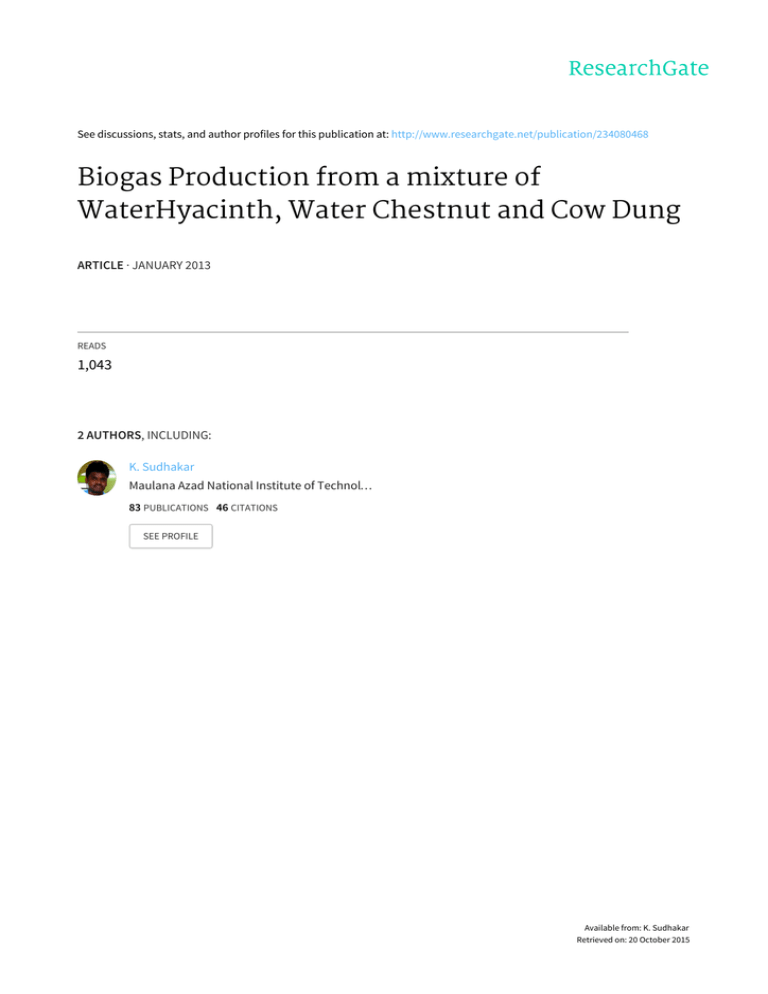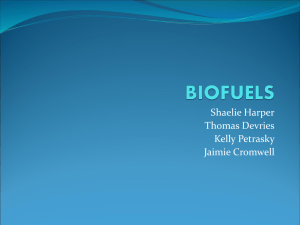
Seediscussions,stats,andauthorprofilesforthispublicationat:http://www.researchgate.net/publication/234080468
BiogasProductionfromamixtureof
WaterHyacinth,WaterChestnutandCowDung
ARTICLE·JANUARY2013
READS
1,043
2AUTHORS,INCLUDING:
K.Sudhakar
MaulanaAzadNationalInstituteofTechnol…
83PUBLICATIONS46CITATIONS
SEEPROFILE
Availablefrom:K.Sudhakar
Retrievedon:20October2015
ISSN: 2278 – 7798
International Journal of Science, Engineering and Technology Research (IJSETR)
Volume 2, Issue 1, January 2013
Biogas Production from a mixture of Water
Hyacinth, Water Chestnut and Cow Dung
K. Sudhakar, R.Ananthakrishnan and Abhishek Goyal
Abstract— There is an increasing need to replace
conventional energy with the renewable energy to save our
natural resources and our environment. Bio-energy seems to be
the most probable solution to this crisis. In this study, the biogas
production potential of the mixture of water chestnut, water
hyacinth and cow dung in the ratio of 1:1:2 has been discussed.
The three variants were charged into a 20L portable
bio-digester in the ratio of 1:1 with water. They were subjected
to anaerobic digestion under a 35 day retention period and
mesophilic temperature range of 26o C-35o C. Volume of per day
biogas production was measured along with the retention time.
Generation of biogas from a mixture of aquatic weeds and cow
dung upholds the concept of waste to wealth in enhancing
sustainability of development. The biogas generated can be
utilized by producing energy from its combustion.
Index Terms— Aquatic weeds, Biogas, Water Chestnut,
Water Hyacinth, Waste.
I. INTRODUCTION
Achieving solutions to possible shortage in fossil fuels and
environmental problems that the world is facing today
requires long-term potential actions for sustainable
development. In this context, renewable energy resources
appear to be one of the most efficient and effective solutions
[1]. Bio-energy is now accepted as having the potential to
provide a major part of the projected renewable energy
provisions of the future [2-3]. Biogas, which is one of the
byproducts of anaerobic digestion, comprises about 60%
methane and 40% carbon dioxide [4]. It has been used as a
source of fuel in several countries such as India, China,
Sweden, Bangladesh etc. for lighting and cooking purposes.
The content of biogas varies with the material being
decomposed and the environmental conditions involved [5].
Biogas production comprises of three stages namely
hydrolysis, acidogenesis and methanogenesis.
(C6H10O5)n + nH2O → n (C6 H12 O6) - Hydrolysis
n(C6H12O6)→nCH3COOH-Acidogenesis
3nCH3COOH → n CH4 + CO2- Methanogenesis
Various wastes have been utilized for biogas production and
they include amongst others; animal wastes [6-8], industrial
wastes [9] and food processing wastes [10]. Aquatic weeds
are one of such biomass being considered as a potential feed
stock [11-13]. A biogas system becomes flammable when its
methane content is at least 45%.Methane has a heating value
of 15.6 MJ/kg [14]. Consequently, biogas can be utilized in
all energy consuming applications designed for natural gas
[15].
Water Hyacinth is recognized as a very aggressive species of
aquatic plant, which grows very fast and eliminates other
aquatic species in its composition [16]. In many places in
India, such as the lakes of Bhopal, water hyacinth continues
to present daunting environmental and economic problems.
Water chestnut is an annual, floating-leaved aquatic plant of
temperate and tropical fresh-water wetlands, rivers, lakes,
ponds, and estuaries. Water chestnut forms extensive dense
beds in lakes, rivers, and freshwater-tidal habitats. Because of
this tendency it is considered as a pest in the U.S. This causes
displacement of aquatic plants, interference with fishing and
boating, as well as the depletion of dissolved oxygen which
adversely affects fish communities [17]. Bhopal is a city
which has several lakes where water hyacinth and water
chestnut are present in plethora.
Consequently, this study was undertaken to investigate the
production of biogas from these aquatic weeds.
II. EXPERIMENTAL
A. Digester Design
The bio-digester was made from a 20L water can as shown in
figure 1. The neck of the can was closed with a cork. By using
aeralyte the neck was made air-tight so as to prevent any
escape of biogas. The cork was drilled and plastic T valve
was inserted. One outlet was connected to a spherical mylar
balloon and the other outlet was connected to Bunsen burner.
The biogas when produced was stored in the mylar ballon.
The bio-digester was placed in the bio-energy lab where
optimum sunlight is available throughout the day. The study
was performed during October-November 2012. The Bunsen
burner was used to check the flammability of the gas.
K. Sudhakar, Assistant Professor, Department of Energy, M.A.N.I.T.
Bhopal 462051, Madhya Pradesh, India
Tel: +91-755-4051000, Fax: +91-755-2670562,
R.Ananthakrishnan ,B.Tech Scholar, , Department of Energy,
M.A.N.I.T. Bhopal 462051, Madhya Pradesh, India,Tel: +919981205755,
Abhishek Goyal, B.Tech Scholar, , Department of Energy, M.A.N.I.T.
Bhopal 462051, Madhya Pradesh, India, Tel: +918989005101,
.
35
All Rights Reserved © 2013 IJSETR
ISSN: 2278 – 7798
International Journal of Science, Engineering and Technology Research (IJSETR)
Volume 2, Issue 1, January 2013
Figure 1: Biodigester setup
B. Preparation and Feeding of Biomass
Water hyacinth (Jal Kumbhi) and Water Chestnut (Singada)
was obtained from lakes of Bhopal. Cow dung was obtained
from the nearby village in MANIT district. 500 gms of both
the aquatic weeds were allowed to dry and then chopped as
shown in figure 2. These dried and chopped aquatic plants
were then mixed with freshly procured cow dung, in the ratio
of 1:2 by volume. The bio-digester was fed with this mixture
along with water in the ratio of 1:1 by volume, making net
volume as 18L. The digester contents were stirred adequately
and on a daily basis to ensure homogenous dispersion of the
constituents of the mixture. Gas production measured in
dm3/kg of slurry (15kg) was obtained by measuring the
diameter of mylar balloon using a measuring tape.
III. RESULTS AND DISCUSSION
The experiment was carried out under ambient temperature
range of 26 to 36oC and within a retention period of 35 days.
The daily biogas production is graphically presented in Fig 3.
The digester commenced biogas production within 24hr of its
charging. The output gas obtained became flammable within
24hr of charging the digester. The gas production and its
flammability reduced drastically on the 17th day and
increased after 22nd day. The cumulative biogas yield of the
paper waste was lower in the first 17 days.
When the biogas production resumed, it was observed that
the production was quite high and continued long until the
blend nearly stopped production. A highest of 1.21L of
biogas was produced on the 19th day. The average per day
production of biogas was 0.326L/day. However when the
flammable biogas production resumed, it was observed that
the gas production was quite high and continued long after
the blend had nearly stopped production. Overall 11.41L of
biogas was accumulated by the end of the retention period.
The general accepted mean calorific value of biogas is
20MJ/m3. The energy that can obtained by 11.41L of biogas
would be 228KJ.
Volume Production in Litres
1.4
1.2
1
0.8
0.6
0.4
0.2
0
1 4 7 10 13 16 19 22 25 28 31 34
Figure 3: Volume of gas production (L) vs Days
Figure 2: Dried and chopped water chestnut
C. Analysis
Gas production was measured in dm3 per kg of slurry (15kg)
by obtaining the diameter of mylar balloon using a measuring
tape. Flammability was checked by igniting the gas at Bunsen
burner.
IV. CONCLUSION
The study has shown that water hyacinth and water chestnut
which can be found in abundance everywhere including the
lakes of Bhopal, are very good feedstock for biogas
production. These aquatic weeds which interfere in the
growth of other aquatic plants and clog lakes making it
difficult for boating, fishing, and swimming, can be utilized
for energy generation. The study has also shown the mixture
of water chestnut, water hyacinth and cow dung gives
sustained gas flammability throughout the digestion period of
the biomass. The biogas obtained can be utilized to replace
the cooking gas to some extent. Biogas can be produced by
organizations near the lakes of the city. Biogas can also be
used in engines by the route of combustion.
36
All Rights Reserved © 2013 IJSETR
ISSN: 2278 – 7798
International Journal of Science, Engineering and Technology Research (IJSETR)
Volume 2, Issue 1, January 2013
REFERENCES
[1]Kaygusuz, K. and Kaygusuz, A., (2002) Renewable
energy and sustainable development in Turkey. Renewable
Energy.25 (3):431-453.
[2]Schuck, S., 2006. Biomass as an energy source. INT. J.
ENVIRON. STUD. 63(6):823-835.
[3] Kaygusuz, K., 2009. Bioenergy as a Clean and
Sustainable Fuel: Energy Sources Part A. 31(12):535-545.
[4] Maishanu, S.M., Musa, M. and Sambo, A.S., (1990)
Biogas Technology: The output of the Sokoto Energy
Research Centre. Nigerian Journal of Solar Energy.
9:183-194.
[5] Anunputtikul, W. and Rodtong, S., (2004) The Joint
International Conference on “Sustainable Energy and
Environmental (SEE)”, Hua Hin, Thailand. 1-3 Dec:
238-243.
[6] Nwagbo, E.E., Dioha, I.J. and Gulma, M.A., (1991)
Qualitative investigation of biogas from Cow and Donkey
dung. Nigerian Journal of Solar Energy. 10:145-149.
[7] Zuru, A.A., Saidu, H., Odum, E.A., and Onuorah,O.
A.,(1998) A comparative study of biogas production from
horse, goat and sheep dungs. Nigerian Journal of Renewable
Energy.6 (1&2):43-47.
[8] Alvarez, R., Villica, R., and Liden, G., (2006) Biogas
production from llama manure at high altitude. Biomass and
Bioenergy. 30: 66-75.
[9] Uzodinma, E.O., Ofoefule, A.U., Eze, J.I. and Onwuka,
N.D., (2007). Biogas Production from blends of
Agro-industrial wastes. Trends in Applied Sciences Research
2 (6): 554-558.
[10] Arvanitoyannis, I.S. and Varzakas, Т.Н., (2008)
Vegetable waste treatment, Critical. Reviews in Food Science
and Nutrition. 48(3):205-247.
[11] Vaidyanathan, S., Kavadia, K.M., Shroff, K.C. and
Mahajan, S.P., (1985) Biogas production in batch and semi
continuous digesters using water hyacinth: Biotechnology
and Bioengineering. 27(6):905-8.
[12] Verma, V.K., Singh, Y.P. and Rai, J.P.N., (2007) Biogas
production from plant biomass used for phytoremediation of
industrial wastes. Bio resource Technology. 98:1664–1669.
[13] Momoh O.L.Y. and Nwaogazie I.L., (2008). Effect of
waste paper on biogas production from co- digestion of cow
dung and water hyacinth in batch reactors. Journal Applied
Science and Environmental Management, 124:95–98.
[14] FAO (1979). China: Azolla Propagation and small
Biogas Technology Agricultural Service Bulletin No.41 FAO
Rome.
[15] Ross, C., (1966). Handbook on Biogas Utilization, 2nd
Edition Muscle shoals. Al Southeastern Regional Biomass
Energy Program, Tennessee Valley Authority.
[16] Holm, L.G., Plucknett, D.L., Pancho,J.V., and
Herberger, J.P.,(1977) The world’s worst weeds: Distribution
and biology. Honolulu: University Press of Hawaii. 609.
[17] Hummel , M. and Kiviat, E., (2004).Review of World
Literature on Water Chestnut with Implications for
Management in North America. J. Aquat. Plant Manage. 42:
17-28
K.Sudhakar obtained his B.E in Mechanical
Engineering from Government College of
Engg., Salem and M.Tech in Energy
Management from School of Energy And
Environmental
Studies,
Devi
Ahilya
University, Indore and Ph.D from National
Insitute of Technology,Tiruchirapalli.. He was
awarded Senior Research Fellowship by DST
and Young Scientist Award by Madhya
Pradesh State Council of Science and
Technology, Bhopal. His major research area
includes:
Climate
Change,
Carbon
Sequestration, Hybrid System, Plant Fuel cell, Algal Bio-fuel, Solar
Thermal & PV Systems,Wind Energy and Energy Conservation. He has
published more than 50 research papers in International Journal and
Conference. He is a Certified Energy Manager & Energy Auditor by BEE.
He has been a keynote speaker and resource person at several
International/National Conferences. He is currently working as Assistant
Professor in Energy Department,Maulana Azad National Institute of
Technology, Bhopal.E-mail address: sudha_k@sify.com
R.Ananthakrishnan. Final year, B.Tech,
energy engineering, Maulana Azad National
Institute of Technology, Bhopal, Madhya
Pradesh. India .He has interests in the field of
Biomass Energy. He has also presented a paper
at the technical festival of IIT-B.
Mr.Ananthakrishnan is currently the Chairman
at the Indian Society for Technical Education
Students Chapter MANIT.
Email address: rakrishnan.iyer@gmail.com
Abhishek Goyal. Final year, B.Tech, energy
engineering, Maulana Azad National Institute
of Technology, Bhopal, Madhya Pradesh.
India. He has interests in the field of Solar,
Wind and Biomass Energy. He is currently
working in the cultivation of algae for biofuel.
He is currently a member of ISTE and SAE
MANIT.
Email: abhishek.goyal798@gmail.com
37
All Rights Reserved © 2013 IJSETR




